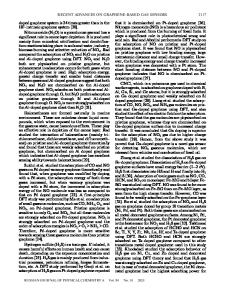Thick-Film Gas Sensors Based on Nano-Sized Semiconducting Oxide Powders
- PDF / 5,573,261 Bytes
- 7 Pages / 604.8 x 806.4 pts Page_size
- 11 Downloads / 248 Views
ional production methods (solidState reactions at high temperatures) have several problems involving grain growth, changes in stoichiometry, and ease of second phase formation.15 This article reviews our work on the use of semiconducting oxide powders for the fabrication of thick films by screenprinting technology. 16 " 22 A comparison of test results has demonstrated that chemically processed nano-sized powders are superior to commercial powders in improving the Performance of subsequent sensors. There are few reports on this approach in the relevant literature; in fact, while there are several groups working on thick-film gas sensors, 23 " 27 only a few used nano-sized powders for the processing of thick films. 28 " 30 Since our purpose is to study gas sensors in environmental-monitoring applications, outdoor field tests were performed using the prepared thick-film prototype sen sors. 31,32 Previously, sensors based on semiconducting oxides have been used only for the control of air quality indoors 33 and inside passenger cars.34'35
Screen-Printing Technology Screen-printing technology is a simple and automated manufacturing technique that allows the production of low-cost and robust chemical sensors 36 with good reproducibility, if the starting materials are well controlled. The preparation of thick films using this technology implies a processing sequence with the following
major Steps: (1) careful selection of the powders of the oxide to be deposited; (2) preparation of pastes (or inks); (3) p r i n t i n g of the properly prepared pastes onto suitable Substrates; (4) drying at low temperatures (150-200°C) to remove the light part of the organic vehicle; and (5) firing at higher temperatures (600-900°C) to form a Consolidated layer with the desired microstructure. This technology has been adapted for the fabrication of layers composed of nano-sized particles. Correct powder se lection is crucial, and many factors have been considered, including grain shape and size, size distribution, intragranular porosity, and surface conditions. In order to print the powder, it is necessary to prepare a viscous paste by adding an or ganic vehicle normally consisting of a rheological agent mixed in a light solvent to ensure the correct rheology necessary for printing. 37 The paste may contain a small percentage of binder (glass frit or reactive metal oxide), for improving the film adhesion to the Substrate, and additivessuchasdopants,catalyzers, orgraingrowth inhibitors. The thickness of the deposited layers may ränge from a few micrometers up to about a hundred micrometers. Drying and firing are performed in belt furnaces, where the temperature profile must be selected to provide the chemical-physical transformations required to obtain the desired layer. The organic vehicle must then be removed completely, leaving behind the inorganic film without affecting its chemistry. For the present work on the preparation of microsensors, the pastes were printed on 96%-alumina Substrates, laser precut into 2 m m X 2 m m Squares, 0.
Data Loading...








